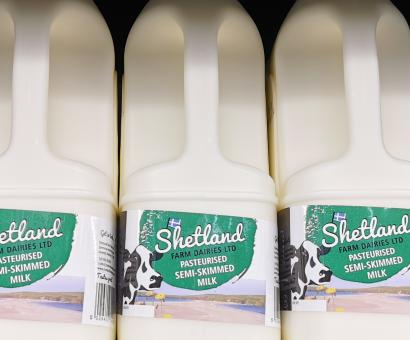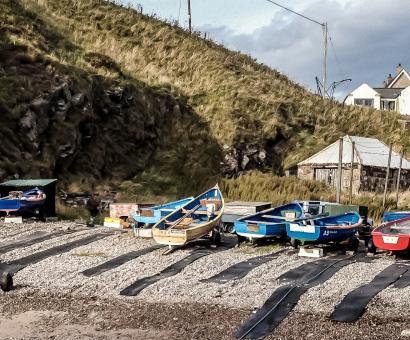Scottish Regional Food Networks
Regional Food Networks in Scotland: A statistical report of locality and types of Regional Food Networks
As Identified in our 2023 discussion paper Local and Regional Food in Scotland there has been a growing interest in local food economies in Scotland (and the rest of the UK and Europe) since the early 2000s. There is further renewed interest in local and regional food, stimulated by the resilience shown by the sector during a prolonged period of turbulence in food supplies caused by Brexit, the Covid-19 pandemic, the cost-of-living crisis, as well as the requirements of many public authorities to publish Good Food Nation Plans as set out in the Good Food Nation (Scotland) Act 2022.
This report presents a snapshot of the location and type of regional food networks in Scotland using available data, with an emphasis on mapping the geographic concentration of food and drink industries across Scotland. More specifically, it explores the data availability and accessibility for identifying and analysing regional food networks: what exists and where; to what extent these sources together support the development of a comprehensive understanding of regional food networks; and what further data or connectivity is required to enable support and growth of regional food in Scotland.
Whilst there are many data sources that contain information about the food produced, retailed and purchased in Scotland, there are currently no definitive datasets for ‘local’ foods. However, there are two main categories of data which may be useful for assessing local and regional food: (i) quantitative administrative data, such as economic growth statistics, HMRC trade data and consumption data through panels such as Kantar; and (ii) qualitative information provided by databases of food businesses, registration of businesses via local authorities for regulatory reasons, or in applications to support schemes.
We reviewed existing datasets with relevance to regional food, to determine their applicability to local and regional food network analysis. We then calculated location quotients for food and drink industries in Scotland to show the relative spatial concentration of individual food and drink industries across Scotland. Data was mapped at local authority and intermediate zone levels and uses the NISRIE peripherality classification in the analysis. Finally, we reviewed the 18 formalised Regional Food Groups in Scotland to determine provision at a regional level.
What did we learn?
Compared to the national context, many of Scotland’s rural and island areas have high concentrations of employment across the range of industries that make up Scotland’s food and drink processing sector. Economies of local authorities classified as Mainly Rural – using the RESAS Urban Rural classification of local authorities - were found to have a higher reliance on food and drink processing, with the highest proportion of employment in each of the food and drink industrial sub-sectors aside from the manufacture of beverages and the manufacture of bakery and farinaceous (starch containing) products in 2022. Whilst there is a lack of data on the use of local and regional food, the quantitative research demonstrates the relative importance of the food and drink sector (excluding agriculture) across Scotland’s regions. As such supply chain or policy changes that impact on specific food and drink sectors can therefore have disproportionate employment impacts in some rural and island communities.
Whilst 56% of the food and drink sector employment was associated with businesses in urban intermediate zones, there was disproportionate reliance on the sector in non-urban regions. The islands accounted for 9% of Scotland’s food and drink employment despite only having a 2% share of Scotland’s total employment. There were similar higher levels of reliance on food and drink sector employment in very remote mainland areas (a 5% share of food and drink employment compared to a 2% share of national employment), remote mainland areas (a 10% share of food and drink employment compared to 3% share of national employment) and accessible mainland areas (a 21% share of food and drink employment compared to a 14% share of national employment).
There was significant variation in the geographic split of food and drink sub-sector employment. For example 50% of aquaculture employment was associated with businesses based in the islands (with a further 30% share of employment in very remote mainland areas). Also, 19% of the fishing sector employment was in island areas, 19% in accessible mainland areas, 12% in very remote mainland areas and 44% in urban areas (noting both Peterhead and Fraserburgh are both classified as urban with populations of more than 10,000 people). Higher local reliance on employment within food and drink sub-sectors, such as the fishing sector, were highlighted through the use of ‘location quotients’ that reveal how important a sector is for local employment in comparison to Scotland-wide sectoral employment. This improves understanding of the geographic concentration of employment in food and drink processing, especially for particular sub-sectors of the industry.
It is important to note that whilst food and drink industries may be located in specific geographies, there may well be wide variations in the level of local and regional consumption of locally produced food and drink. That said, the analysis found that some sectors were more important as a source of regional employment compared to nationally, such as:
- The manufacture of dairy products in areas of Dumfries and Galloway, and Orkney.
- Processing and preserving of fish, crustaceans and molluscs in island and rural Scotland.
- Processing and preserving of meat and the production of meat products in parts of Dumfries and Galloway, and Perth and Kinross.
- Whilst the manufacture of bakery and farinaceous products occurs across most of Scotland’s local authorities, there is higher density concentrated in parts of Moray, Aberdeenshire and the Shetland Islands.
- The manufacturing of beverages in Moray (Speyside).
- Fishing in Shetland and Aberdeenshire (Fraserburgh and Peterhead).
Whilst there are many data sources that contain information about the food produced, retailed and purchased in Scotland, there is currently no definitive dataset for ‘local’ food. As this report highlights however, there are many directories and databases which provide a good starting place, and suggestions can be made to improve data availability for future analysis. This research concludes that there is a need to clarify definitions and parameters, not only of ‘local’ and ‘regional’ food, but all metrics relating to the food, drink and hospitality sectors, so that data can be more easily matched up. A common platform for reporting data that could allow monitoring of regional food networks in Scotland should be explored with these groups to help support the Good Food Nation transition.







